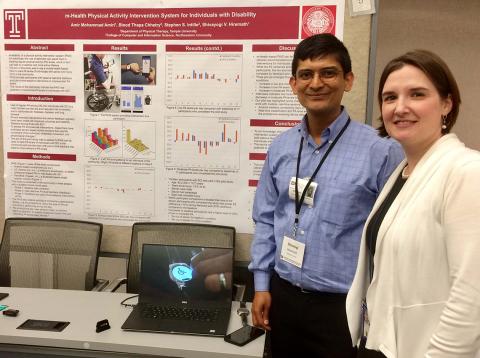NIH Hosts mHealth Technology Showcase for Health Researchers, Device Developers

Photo: Raymond Macdougall and Meredith Daly
The mobile device in your pocket or on your wrist might help you pursue your own healthy lifestyle goals, but it also could contribute to new explorations into health interventions and public health research.
NIH hosted more than 300 university-based and industry technology developers, federal researchers and program staff eager to explore opportunities in health research using mobile technologies. The mHealth Technology Showcase—a recent 1-day meeting—provided the opportunity for developers and researchers to discuss ways to work together.
Mobile health—or mHealth—has evolved over the past decade to encompass varied tools and strategies. The field now boasts wearable and mobile sensors for data collection, mobile apps for self-monitoring and intervention, software platforms for large studies, software tools for big-data analysis and an array of new biomarkers for research.
The range of mHealth tools makes it possible to measure dynamic changes in an individual’s health state, as well as physical, biological, behavioral, social and environmental factors that contribute to health and disease risk in the wider community.

Photo: Raymond Macdougall and Meredith Daly
“Mobile health has been around since the 1940s, when it meant a truck with an X-ray machine going town to town screening for tuberculosis,” said Dr. William Riley, director of the NIH Office of Behavioral and Social Sciences Research, during his keynote address. NIH’s mHealth tech event, he added, gathered leading developers and designers together to advance the field.
During the exhibition portion of the showcase, presenters demonstrated the latest technology and gadgetry, including assorted wearables—from wristbands to eyeglasses, smartphone apps and software for assembling and displaying data.
“The presentations were impressive, particularly devices designed to promote physical activity for people with disabilities,” said Dr. Theresa Cruz, a program officer with NICHD’s National Center for Medical Rehabilitation Research.
The MD2K (Mobile Sensor Data-to-Knowledge) Center of Excellence, led by meeting co-organizer Dr. Santosh Kumar of the University of Memphis, was instrumental in gathering colleagues in the field as presenters and speakers. The center includes participation by 11 universities and university medical centers and debuted in 2015 with NIH funding to develop hardware and software for compiling data from wearable sensors.

Photo: Raymond Macdougall and Meredith Daly
“Four years ago, when MD2K was created, it would have taken a dedicated research lab to run a single 50-person field study,” said Dr. Timothy Hnat, MD2K chief software architect, discussing studies his center has undertaken. “Now, our platform has been successfully deployed for 10 concurrent studies at independent locations throughout the United States.”
These studies will enroll 2,200 participants and accumulate approximately 4.7 trillion data samples. “The largest of these studies supported 400 simultaneous participants in 3 separate sites,” he said.
“We received an extraordinary response for the showcase from both the technology development and research communities,” said Dr. Tiffani Bailey Lash, director of NIBIB’s programs in connected health (mHealth and telehealth) and point-of-care technologies, who was part of the organizing committee. “It is important to work collectively to both take advantage of the array of mHealth technologies that are possible today, but also to think about the best ways to apply them in the future to gain answers to important health questions.”
